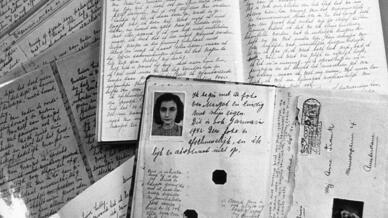From france24.com
Thirteen-year-old Anne Frank began keeping her now-famous diary on June 12, 1942. She would spend a little more than two years confiding in its pages, sharing stories from daily life, observations, and hopes for the future from the cramped annex in Amsterdam she occupied with her family and several other Jews in hiding. The last entry in her diary is dated August 1, 1944, after which she was arrested and deported.
“I hope I will be able to confide everything to you, as I have never been able to confide in anyone, and I hope you will be a great source of comfort and support.” Anne Frank's diary begins with these now-famous words. Her book, published by her father in 1947, has become a landmark of world literature in its singular account of innocence in the face of barbarism.
Born in Frankfurt in 1929, Anne Frank emigrated with her family to the Netherlands in 1933, when Adolf Hitler became chancellor of a crisis-ridden Germany. In 1942, as the authorities tracked down Jews in the Nazi-occupied Netherlands, the Frank family moved into the 'annex', a flat hidden behind a false bookcase, to escape the Gestapo.
In August 1944, the family was betrayed by an unknown individual, and the inhabitants of the annex were deported to Auschwitz. Afterwards, Anne and her sister were transferred to Bergen-Belsen. Anne died of typhus in February or March 1945, shortly after the death of her older sister Margot.
Only 38,000 of the 140,000 Jews living in the Netherlands survived the Nazi occupation, one of the highest Holocaust death tolls in Europe. Dutch professor Johannes Houwink ten Cate, from the Institute for War, Holocaust and Genocide Studies (NIOD) in Amsterdam, reflects on the significance of this literary work.
FRANCE 24: When Anne Frank started writing her diary in June 1942, what was her life like?
Johannes Houwink ten Cate: She led the ordinary life of a middle-class Jewish teenage girl living in Amsterdam. Her family was relatively modest – her father was a businessman, but not a very successful one. She lived in the Rivierenbuurt ('river district'), while the wealthier German Jews lived in the south of Amsterdam.
Anne Frank did not have a religious upbringing. She came from a liberal German-Jewish background whose liberal and humanist ideals deeply influenced her. This is part of the appeal of her diary – even in moments of crisis in the secret annex, she holds firm to her beliefs.
She was well-assimilated into society and not a very orthodox Jew. For instance, she writes about her dream of going to Hollywood and becoming a movie star. In many ways, she was a normal adolescent girl: she experimented with kissing a female friend and fought a lot with her mom.
However, when her diary was first published in 1947, these passages were edited out by her father Otto Frank. They were only made public in 1986, when the Dutch State Institute for War Documentation published the “scientific” version of the diary – a response to legal questions in Western Germany, where some denied the diary’s authenticity.
Why do you think she decided to write about her daily life in this diary?
During the Nazi occupation, many people in both Western and Eastern Europe started writing diaries to document their experiences – and to regain some form of control over their lives, which they had lost under the Nazis. This was also the case with Anne Frank. In her diary, she created an imaginary friend, Kitty, who was also her alter ego. I think that through her diary, she fought her feelings of isolation and loneliness. In the beginning, she wrote only for herself. Later on, she decided that her diary ought to be published and started rewriting it. In this way, she turned it into a work of literature and a coming-of-age story.
How do you explain the success of Anne Frank’s diary and its continuing appeal to younger generations?
Anne Frank was an innocent child, an adolescent girl. My guess is that young girls will always be able to identify with her. As long as there are 13-year-olds, her diary will be read all around the world. Since 2011, there is even a Chinese translation.
Also, she is non-religious and therefore appeals to a non-Jewish audience. She never loses faith in humanity. The Holocaust is not mentioned in her story – there is no murder and no camps. At the same time, the diary is all about the Holocaust, because the modern reader knows for a fact what Anne herself could not have known at the time she was writing – that she, too, would be murdered in Bergen-Belsen as one of the six million Jews who died under the Nazi regime.
The book "Who betrayed Anne Frank?" by Canadian author Rosemary Sullivan argued that the Jewish notary Arnold van den Bergh revealed the Franks’ hiding place in 1944 in Amsterdam. You have said that there are too many errors in this book. Can you explain the controversy?
One of most important errors that the writers of this book made was believing that the notary, as an alleged “collaborator”, had close relations with the Nazis. They also insufficiently took into account the fact that Van den Bergh had gone into hiding himself six months before the Franks were arrested. Big allegations such as this one require substantial proof, and that proof was not presented in the book.
In the United States, the most recent books about Anne Frank, such as the biographies by Melissa Müller and Carole Anne, reveal new “betrayers”. During my career as a Holocaust researcher, I have heard of seven different betrayers. Americans (and not only Americans) love these kinds of detective stories, but they are not really scientific investigations.
This article is a translation of the original in French by Diana Liu

No comments:
Post a Comment